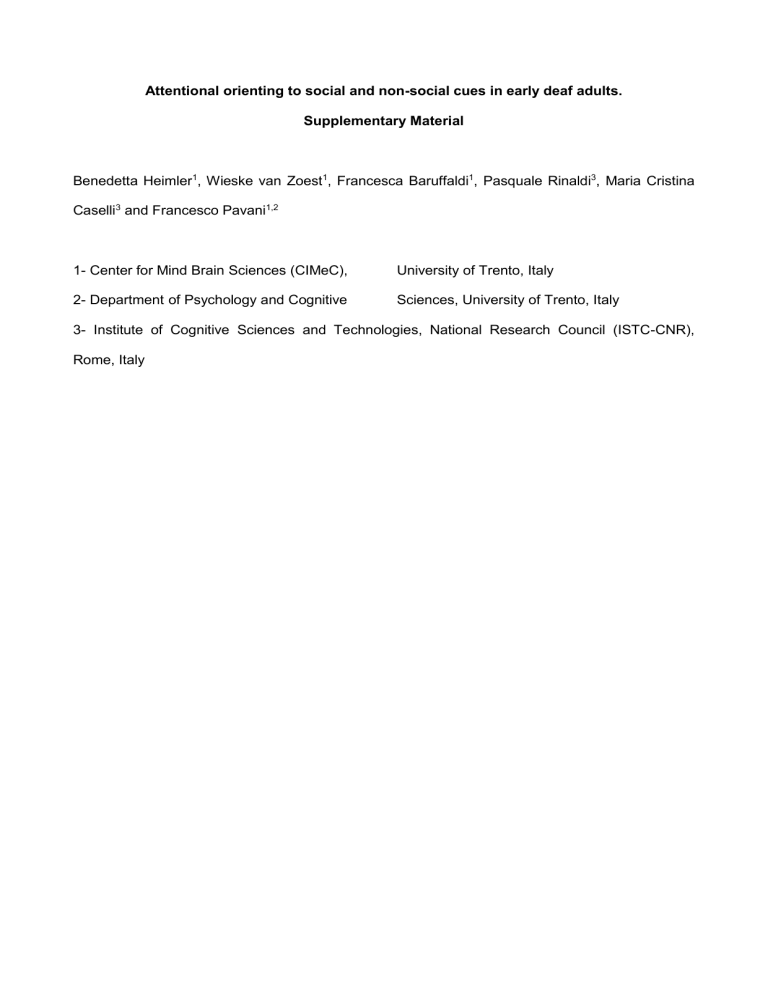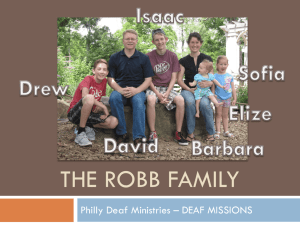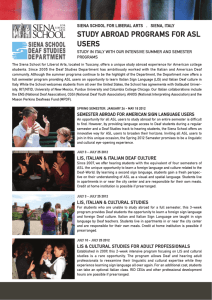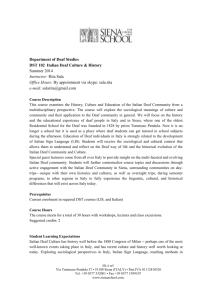xhp-XHP-2014-0281-ASM_Linguistic

Attentional orienting to social and non-social cues in early deaf adults.
Supplementary Material
Benedetta Heimler 1 , Wieske van Zoest 1 , Francesca Baruffaldi 1 , Pasquale Rinaldi 3 , Maria Cristina
Caselli 3 and Francesco Pavani 1,2
1- Center for Mind Brain Sciences (CIMeC),
2- Department of Psychology and Cognitive
University of Trento, Italy
Sciences, University of Trento, Italy
3- Institute of Cognitive Sciences and Technologies, National Research Council (ISTC-CNR),
Rome, Italy
LIS Assessment
All linguistic tests were prepared ad-hoc by the ISTC-CNR personnel. LIS assessment was conducted by deaf research assistants, with all instructions provided in LIS. All deaf participants completed a comprehension task and a sentence repetition task.
Comprehension task
Deaf participants watched a 5 minutes video of a story in LIS. Then participants had to answer to
12 forced-choice questions regarding the signed story they just saw.
Repetition task
Deaf participants were presented with 15 sentences in LIS, of increasing length and difficulty. The sentences were presented through a video, one at a time, and repeated if necessary. Deaf participants were instructed to repeat in signs exactly the same sentence. The entire test was recorded by a video-camera.
Italian Assessment
All these LIS tests are part of a larger battery developed by the ISTC-CNR group to assess the level of bimodal bilingualism (sign language and spoken language) in deaf adults. To this aim the battery also included tests for the assessment of the proficiency in spoken and written Italian. The
Italian comprehension task was a standardized test (see below). All the other tests were developed ad-hoc by the ISTC-CNR personnel.
Comprehension task
To assess comprehension abilities in deaf participants we used a standardized test for written
Italian used for students starting the 8 th grade (Cornoldi & Colpo, 1995). Deaf participants read a text in Italian and answered 12 forced-choice questions regarding the text.
Repetition task
Deaf participants were presented with 10 sentences in spoken Italian, of increasing length and difficulty. The experimenter said the sentence once (and repeated it if necessary) and deaf participants were instructed to repeat exactly the same sentence. The entire test was recorded by a video-camera.
Production task
Deaf participants watched twice a 2 minutes cartoon. They were then asked to report to the experimenter what they have seen using spoken Italian. Subsequently, they were asked to summarize in a written text the plot of the cartoon. The entire test was recorded by a videocamera.
Specific results of this comprehensive linguistic assessment will be described in full details in future reports.









